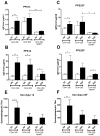Response to Pneumococcal Polysaccharide Vaccination in Newly Diagnosed HIV-Positive Individuals
- PMID: 25908995
- PMCID: PMC4405239
- DOI: 10.4172/2155-6113.1000419
Response to Pneumococcal Polysaccharide Vaccination in Newly Diagnosed HIV-Positive Individuals
Abstract
Background: Newly diagnosed HIV-positive individuals are 35 to 100-fold more susceptible to Streptococcus pneumoniae infection compared to non-infected individuals. Therefore, the 23-valent pneumococcal polysaccharide vaccine (PPV23) has previously been recommended, though efficacy and effectiveness of vaccination remains controversial. Early severe B cell dysfunction is a central feature of HIV infection. The specific nature of the immune cells involved in the production of protective antigen-specific antibodies in HIV-positive individuals remains to be elucidated.
Objectives: Evaluate the antibody and antigen-specific B cell response to the 23-valent pneumococcal polysaccharide vaccine in newly diagnosed HIV-positive patients. Moreover, determine if newly diagnosed patients with CD4<200 cells/μl benefit from 6-12 months of HAART, allowing partial viral suppression and immune reconstitution, prior to immunization.
Methods: Newly diagnosed HIV-positive patients with CD4>200 cells/μl and CD4<200 cells/μl were immunized with PPV23. Patients with CD4<200 cells/μl received either immediate or delayed immunization following 6-12 months of HAART. Antibody responses, opsonophagocytic activity and phenotypic analysis of pneumococcal polysaccharide-specific B cells were studied.
Results: Newly diagnosed HIV-positive patients demonstrated CD4-dependent increases in antibody and opsonophagocytic titers thought to be commensurate with protection. Functional opsonophagocytic titers of patients with CD4<200 cells/μl immunized immediately compared to patients with CD4<200 cells/μl receiving HAART for 6-12 months were not significantly different. Pneumococcal polysaccharide-specific B cells were distributed evenly between IgM memory and switched memory B cells for all groups, but IgM memory B cells were significantly lower than in HIV-negative individuals.
Conclusions: Despite CD4-dependent pneumococcal polysaccharide-specific deficiencies in newly diagnosed HIV-positive patients, vaccination was beneficial based on opsonophagocytic titers for all newly diagnosed HIV-positive groups. In HIV-positive patients with CD4<200 cells/μl, 6-12 months of HAART did not improve opsonophagocytic titers or antibody concentrations. Based on these findings, immunization with the 23-valent pneumococcal polysaccharide vaccine should not be delayed in newly diagnosed HIV-positive patients with CD4<200 cells/μl.
Keywords: Antigen-specific; B cell; HIV; Pneumococcus; Polysaccharide; Streptococcus pneumonia; Vaccine.
Figures



Similar articles
-
Response to Pneumococcal Polysaccharide Vaccination in HIV-Positive Individuals on Long Term Highly Active Antiretroviral Therapy.J AIDS Clin Res. 2015 Feb;6(2):421. doi: 10.4172/2155-6113.1000421. J AIDS Clin Res. 2015. PMID: 25908996 Free PMC article.
-
Immunogenicity and Immunological Memory Induced by the 13-Valent Pneumococcal Conjugate Followed by the 23-Valent Polysaccharide Vaccine in HIV-Infected Adults.J Infect Dis. 2018 Jun 5;218(1):26-34. doi: 10.1093/infdis/jiy135. J Infect Dis. 2018. PMID: 29722823
-
The effect of pneumococcal immunization on total and antigen-specific B cells in patients with severe chronic kidney disease.BMC Immunol. 2019 Nov 12;20(1):41. doi: 10.1186/s12865-019-0325-9. BMC Immunol. 2019. PMID: 31718534 Free PMC article.
-
Pneumococcal vaccination among HIV-infected adult patients in the era of combination antiretroviral therapy.Hum Vaccin Immunother. 2014;10(12):3700-10. doi: 10.4161/hv.32247. Hum Vaccin Immunother. 2014. PMID: 25483681 Free PMC article. Review.
-
Humoral immune responses to Streptococcus pneumoniae in the setting of HIV-1 infection.Vaccine. 2015 Aug 26;33(36):4430-6. doi: 10.1016/j.vaccine.2015.06.077. Epub 2015 Jun 30. Vaccine. 2015. PMID: 26141012 Free PMC article. Review.
Cited by
-
Immunogenicity and safety of 13-valent pneumococcal conjugate vaccine in HIV-infected adults in the era of highly active antiretroviral therapy: analysis stratified by CD4 T-cell count.Hum Vaccin Immunother. 2020;16(1):169-175. doi: 10.1080/21645515.2019.1643677. Epub 2019 Aug 23. Hum Vaccin Immunother. 2020. PMID: 31441710 Free PMC article. Clinical Trial.
-
Alterations in serotype-specific B cell responses to the 13-valent pneumococcal conjugate vaccine in aging HIV-infected adults.Vaccine. 2016 Jan 20;34(4):451-457. doi: 10.1016/j.vaccine.2015.12.013. Epub 2015 Dec 18. Vaccine. 2016. PMID: 26707220 Free PMC article. Clinical Trial.
-
Quantitative and Functional Antibody Responses to the 13-Valent Conjugate and/or 23-Valent Purified Polysaccharide Vaccine in Aging HIV-Infected Adults.J AIDS Clin Res. 2016 Mar;7(3):556. doi: 10.4172/2155-6113.1000556. Epub 2016 Mar 14. J AIDS Clin Res. 2016. PMID: 27158552 Free PMC article.
-
Race-related differences in functional antibody response to pneumococcal vaccination in HIV-infected individuals.Vaccine. 2019 Mar 14;37(12):1622-1629. doi: 10.1016/j.vaccine.2019.01.084. Epub 2019 Feb 21. Vaccine. 2019. PMID: 30797636 Free PMC article.
-
Immunogenicity of pneumococcal vaccination in HIV infected individuals: A systematic review and meta-analysis.EClinicalMedicine. 2020 Nov 23;29-30:100576. doi: 10.1016/j.eclinm.2020.100576. eCollection 2020 Dec. EClinicalMedicine. 2020. PMID: 33294820 Free PMC article.
References
-
- Grau I, Pallares R, Tubau F, Schulze MH, Llopis F, et al. Epidemiologic changes in bacteremic pneumococcal disease in patients with human immunodeficiency virus in the era of highly active antiretroviral therapy. Arch Intern Med. 2005;165:1533–1540. - PubMed
-
- Heffernan RT, Barrett NL, Gallagher KM, Hadler JL, Harrison LH, et al. Declining incidence of invasive Streptococcus pneumoniae infections among persons with AIDS in an era of highly active antiretroviral therapy, 1995–2000. J Infect Dis. 2005;191:2038–2045. - PubMed
-
- Janoff EN, Breiman RF, Daley CL, Hopewell PC. Pneumococcal disease during HIV infection. Epidemiologic, clinical, and immunologic perspectives. Ann Intern Med. 1992;117:314–324. - PubMed
-
- Yin Z, Rice BD, Waight P, Miller E, George R, et al. Invasive pneumococcal disease among HIV-positive individuals, 2000–2009. AIDS. 2012;26:87–94. - PubMed
Grants and funding
LinkOut - more resources
Full Text Sources
Other Literature Sources
Research Materials
